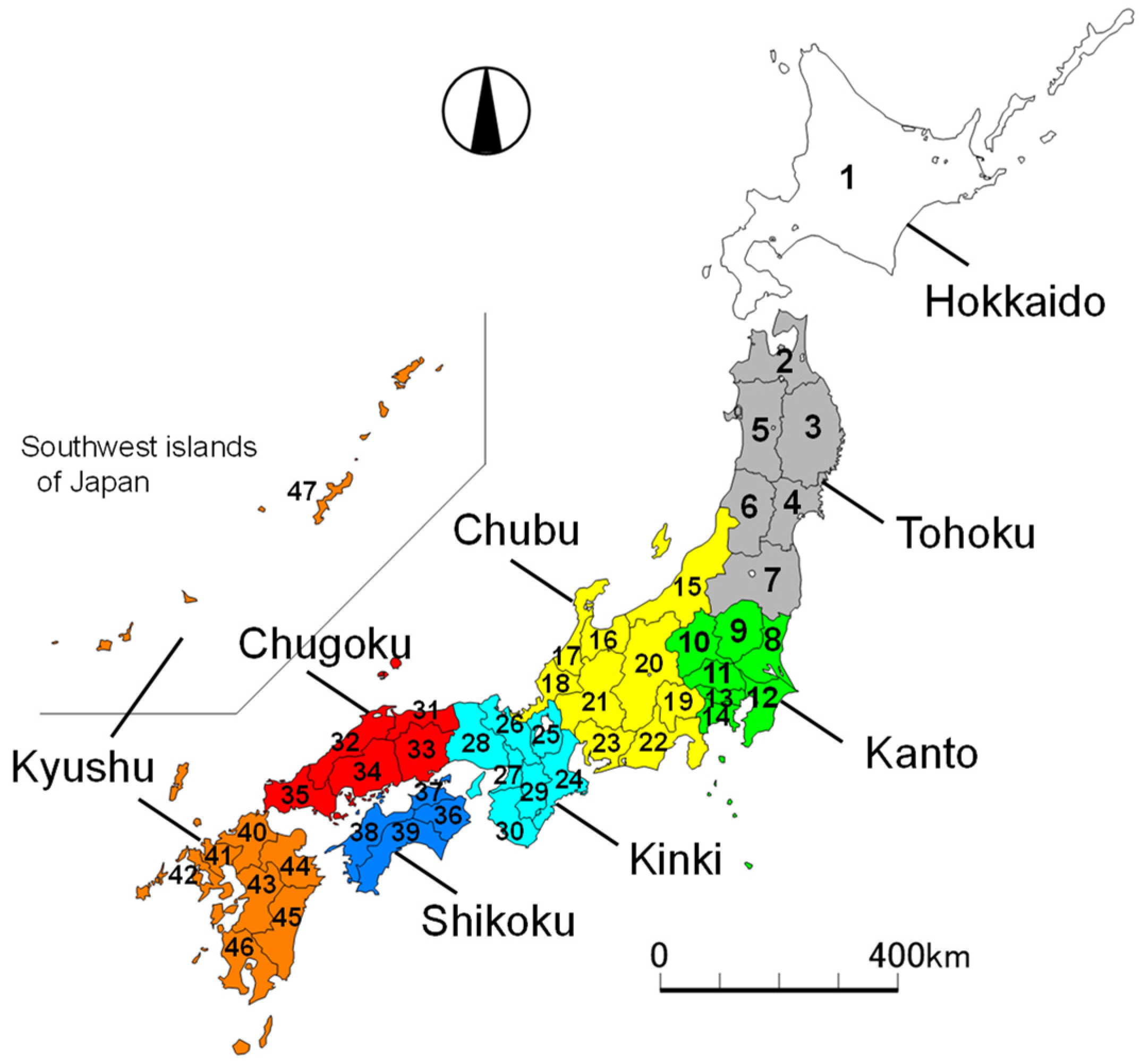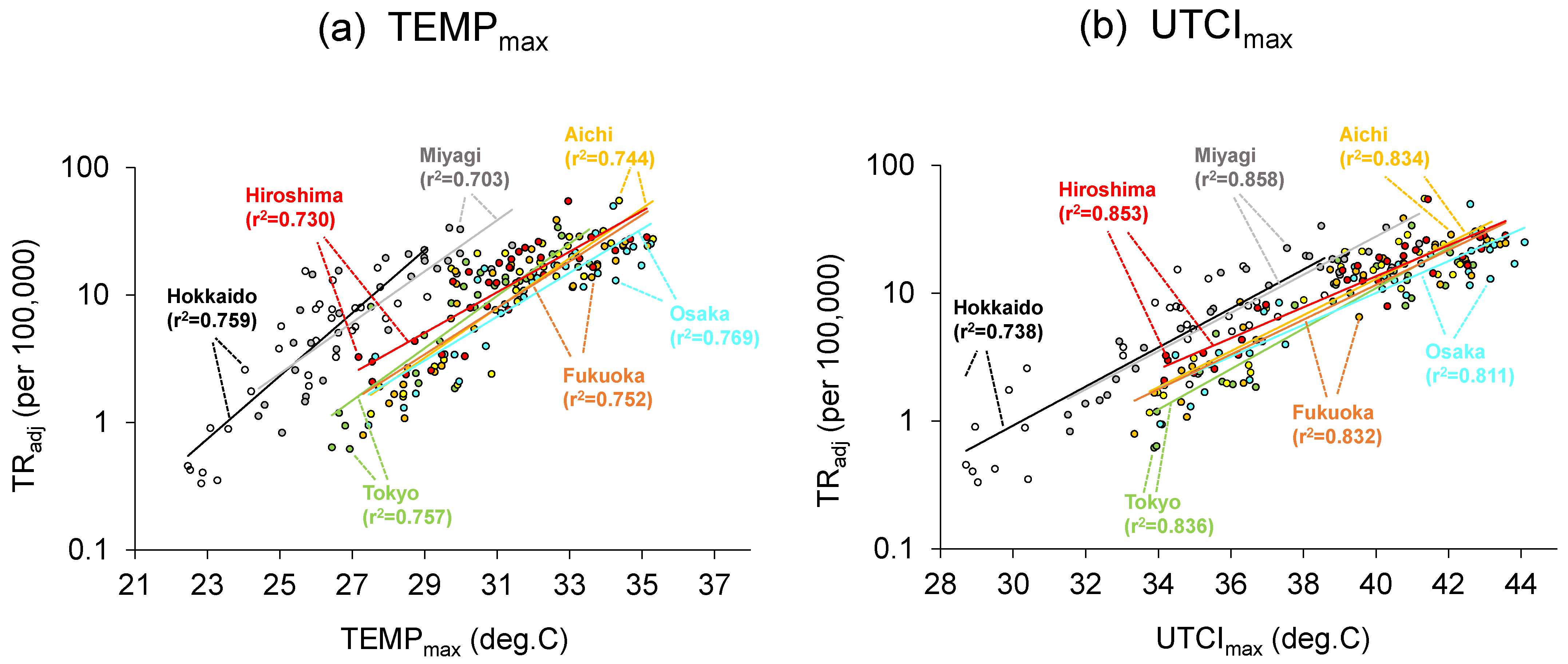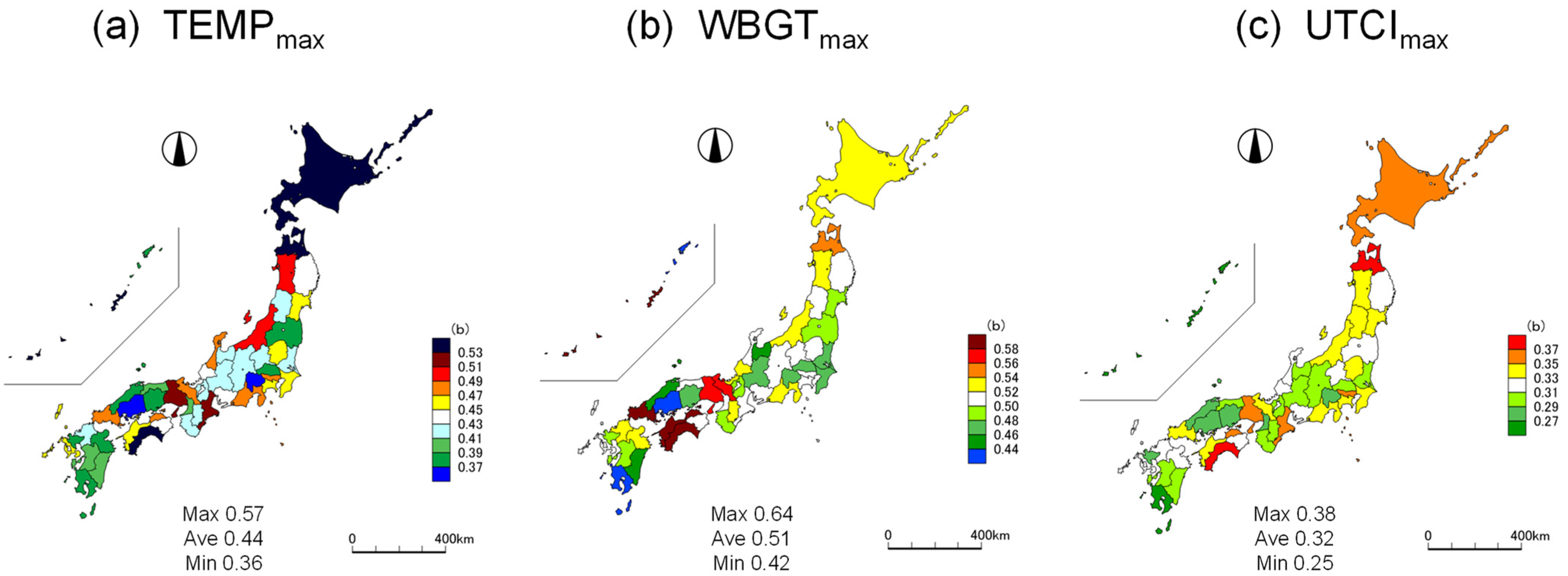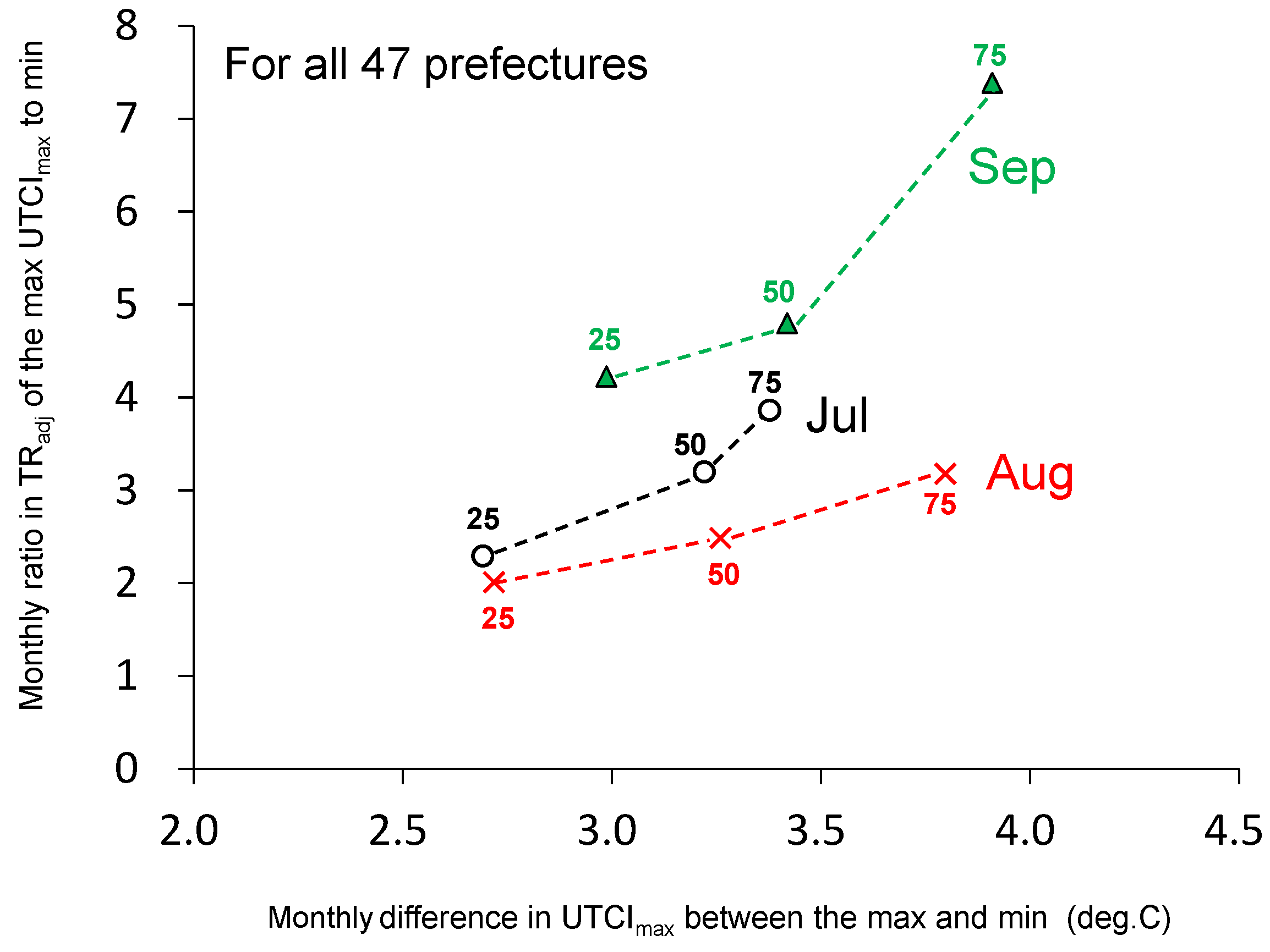Assessing the Climatological Relationship between Heatstroke Risk and Heat Stress Indices in 47 Prefectures in Japan
Abstract
:1. Introduction
2. Materials and Methods
2.1. Heatstroke Transport Data
2.2. Heat Stress Indices

3. Results and Discussion
3.1. Decade Distributions in 47-Prefecture Scale
3.2. Vulnerability to Heat Stress Conditions
3.3. Heatstroke Risk of Hot to Cool Months
4. Conclusions
- (1)
- Analysed results obtained from the decade averaging preview.
- (2)
- Analysed results obtained from monthly averaging—heat vulnerability.
- (3)
- Analysed results obtained from monthly averaging—heatstroke risk.
Supplementary Materials
Author Contributions
Funding
Institutional Review Board Statement
Informed Consent Statement
Data Availability Statement
Acknowledgments
Conflicts of Interest
References
- World Health Organization. Ten Threats to Global Health in 2019. Available online: https://www.who.int/news-room/spotlight/ten-threats-to-global-health-in-2019 (accessed on 19 September 2021).
- Fire and Disaster Management Agency. Disaster Information. Available online: https://www.fdma.go.jp/disaster/heatstroke/ (accessed on 19 September 2021). (In Japanese)
- Nakai, S.; Itoh, T.; Morimoto, T. Deaths from heat-stroke in Japan: 1968–1994. Int. J. Biometeorol. 1999, 43, 124–127. [Google Scholar] [CrossRef]
- Makie, T.; Harada, M.; Kinukawa, N.; Toyoshiba, H.; Yamanaka, T.; Nakamura, T.; Sakamoto, M.; Nose, Y. Association of meteorological and day-of-the-week factors with emergency hospital admissions in Fukuoka, Kapan. Int. J. Biometeorol. 2002, 46, 38–41. [Google Scholar] [CrossRef] [PubMed]
- Hoshi, A.; Inaba, Y. Meteorological conditions and sports deaths at school in Japan, 1993–1998. Int. J. Biometeorol. 2005, 49, 224–231. [Google Scholar] [CrossRef] [PubMed]
- Ooka, R. Recent development of assessment tools for urban climate and heat-island investigation especially based on experiences in Japan. Int. J. Climatol. 2007, 27, 1919–1930. [Google Scholar] [CrossRef]
- Fujibe, F. Detection of urban warming in recent temperature trends in Japan. Int. J. Climatol. 2009, 29, 1811–1822. [Google Scholar] [CrossRef]
- Ohashi, Y.; Kikegawa, Y.; Ihara, T.; Sugiyama, N. Numerical simulations of outdoor heat stress index and heat disorder risk in the 23 wards of Tokyo. J. Appl. Meteorol. Climatol. 2014, 53, 583–597. [Google Scholar] [CrossRef]
- Takaya, A.; Morioka, Y.; Behera, S.K. Role of climate variability in the heatstroke death rates of Kanto region in Japan. Sci. Rep. 2014, 4, 5655. [Google Scholar]
- Akatsuka, S.; Uno, T.; Horiuchi, M. The relationship between the heat disorder incidence rate and heat stress indices at Yamanashi Prefecture in Japan. Adv. Meteorol. 2016, 2016, 9492815. [Google Scholar] [CrossRef] [Green Version]
- Sato, T.; Kusaka, H.; Hino, H. Quantitative assessment of the contribution of meteorological variables to the prediction of the number of heat stroke patients for Tokyo. SOLA 2020, 16, 104–108. [Google Scholar] [CrossRef]
- Fujibe, F.; Matsumoto, J.; Suzuki, H. Spatial and temporal features of heat stroke mortality in Japan and their relation to temperature variations, 1999–2014. Geogr. Rev. Jpn. Ser. B 2018, 91, 17–27. [Google Scholar]
- Ministry of the Environment. How Much Heatstroke Is Occurring? Available online: https://www.wbgt.env.go.jp/pdf/envman/1-3.pdf (accessed on 19 September 2021). (In Japanese)
- Moran, D.S.; Shapiro, Y.; Epstein, Y.; Matthew, W.; Pandolf, K.B. A modified discomfort index (MDI) as an alternative to the wet bulb globe temperature (WBGT). Environ. Ergon. 1998, 8, 77–80. [Google Scholar]
- Jendritzky, G.; Maarouf, A.; Staiger, H. Looking for a Universal Thermal Climate Index UTCI for outdoor applications. In Proceedings of the Windsor-Conference on Thermal Standards, Windsor, UK, 5–8 April 2001; pp. 353–367. [Google Scholar]
- Nastos, P.T.; Matzarakis, A. Human-biometeorological effects on sleep disturbances in Athens, Greece: A preliminary evaluation. Indoor Built Environ. 2008, 17, 535–542. [Google Scholar] [CrossRef]
- Solymosi, N.; Torma, C.; Kern, A.; Maróti-Agóts, A.; Barcza, Z.; Könyves, L.; Berke, O.; Reiczigel, J. Changing climate in Hungary and trends in the annual number of heat stress days. Int. J. Biometeorol. 2010, 54, 423–431. [Google Scholar] [CrossRef] [PubMed]
- Willett, K.M.; Sherwood, S. Exceedance of heat index thresholds for 15 regions under a warming climate using the wet-bulb globe temperature. Int. J. Climatol. 2012, 32, 161–177. [Google Scholar] [CrossRef]
- Kershaw, S.E.; Millward, A.A. A spatio-temporal index for heat vulnerability assessment. Environ. Monit. Assess. 2012, 184, 7329–7342. [Google Scholar] [CrossRef]
- Giannaros, T.M.; Melas, D.; Matzarakis, A. Evaluation of thermal bioclimate based on observational data and numerical simulations: An application to Greece. Int. J. Biometeorol. 2015, 59, 151–164. [Google Scholar] [CrossRef]
- Basarin, B.; Lukic, T.; Matzarakis, A. Quantification and assessment of heat and cold waves in Novi Sad, Northern Serbia. Int. J. Biometeorol. 2016, 60, 139–150. [Google Scholar] [CrossRef]
- Napoli, C.D.; Pappenberger, F.; Cloke, H.L. Assessing heat-related health risk in Europe via the universal thermal climate index (UTCI). Int. J. Biometeorol. 2018, 62, 1155–1165. [Google Scholar] [CrossRef] [PubMed] [Green Version]
- Tomczyk, A.M.; Bednorz, E.; Matzarakis, A. Human-biometeorological conditions during heat waves in Poland. Int. J. Climatol. 2020, 40, 5043–5055. [Google Scholar] [CrossRef]
- Vinogradova, V. Using the Universal Thermal Climate Index (UTCI) for the assessment of bioclimatic conditions in Russia. Int. J. Biometeorol. 2021, 65, 1473–1483. [Google Scholar] [CrossRef] [PubMed]
- Fujibe, F.; Matsumoto, J.; Suzuki, H. Regional features and temporal variations of heat-stroke ambulance transport rates in Japan –Comparison with mortality. J. Heat Isl. Inst. Int. 2020, 15, 1–13. (In Japanese) [Google Scholar]
- Fire and Disaster Management Agency. Heatstroke Information. Available online: http://www.fdma.go.jp/neuter/topics/fieldList9_2.html (accessed on 19 September 2021). (In Japanese)
- Yaglou, C.P.; Minard, C.D. Control of heat casualties at military training centers. AMA Arch. Indust. Health 1957, 16, 302–316. [Google Scholar]
- Jendritzky, G.; Maarouf, A.; Fiala, D.; Staiger, H. An update on the development of a Universal Thermal Climate Index. In Proceedings of the 15th Conference on Biometeorological Aerobiology and 16th ICB02, American Meteorological Society, Kansas City, MO, USA, 27 October–1 November 2002; pp. 129–133. [Google Scholar]
- Błażejczyk, K.; Jendritzky, G.; Bröde, P.; Fiala, D.; Havenith, G.; Epstein, Y.; Psikuta, A.; Kampmann, B. An introduction to the universal thermal climate index (UTCI). Geog. Pol. 2013, 86, 5–10. [Google Scholar] [CrossRef] [Green Version]
- Jendritzky, G.; Höppe, P. The UTCI and the ISB. Int. J. Biometeorol. 2017, 61, S23–S27. [Google Scholar] [CrossRef]
- Bröde, P.; Fiala, D.; Błażejczyk, K.; Holmér, I.; Jendritzky, G.; Kampmann, B.; Tinz, B.; Havenith, G. Deriving the operational procedure for the Universal Thermal Climate Index (UTCI). Int. J. Biometeorol. 2012, 56, 481–494. [Google Scholar] [CrossRef] [PubMed] [Green Version]
- Budd, G.M. Wet-bulb globe temperature (WBGT)—Its history and its limitations. J. Sci. Med. Sport 2018, 11, 20–32. [Google Scholar] [CrossRef]
- Błażejczyk, K.; Kuchcik, M.; Błażejczyk, A.; Milewksi, P.; Szmyd, J. Assessment of urban thermal stress by UTCI—Experimental and modelling studies: An example from Poland. DIE ERDE 2014, 145, 16–33. [Google Scholar]
- Provençal, S.; Bergeron, O.; Leduc, R.; Barrette, N. Thermal comfort in Quebec City, Canada: Sensitivity analysis of the UTCI and other popular thermal comfort indices in a mid-latitude continental city. Int. J. Biometeorol. 2016, 60, 591–603. [Google Scholar] [CrossRef]
- Hosokawa, Y.; Adams, W.M.; Belval, L.N.; Davis, R.J.; Huggins, R.A.; Jardine, J.F.; Katch, R.K.; Streams, R.L.; Casa, D.J. Exertional heat illness incidence and on-site medical team preparedness in warm weather. Int. J. Biometeorol. 2018, 62, 1147–1153. [Google Scholar] [CrossRef] [PubMed]
- Zare, S.; Hasheminejad, N.; Shirvan, H.E.; Hemmatjo, R.; Sarebanzadeh, K.; Ahmadi, S. Comparing Universal Thermal Climate Index (UTCI) with selected thermal indices/environmental parameters during 12 months of the year. Weather Clim. Extrem. 2018, 19, 49–57. [Google Scholar] [CrossRef]
- The Japan Meteorological Agency. The Past Meteorological Data. Available online: https://www.data.jma.go.jp/obd/stats/etrn/index.php (accessed on 19 September 2021). (In Japanese)
- The Ministry of the Environment. Heat Illness Prevention Information. Available online: https://www.wbgt.env.go.jp/wbgt_data.php (accessed on 19 September 2021).
- Błażejczyk, K.; Epstein, Y.; Jendritzky, G.; Staiger, H.; Tinz, B. Comparison of UTCI to selected thermal indices. Int. J. Biometeorol. 2012, 56, 515–535. [Google Scholar] [CrossRef] [PubMed] [Green Version]
- Zare, S.; Shirvan, H.E.; Hemmatjo, R.; Nadri, F.; Jahani, Y.; Jamshidzadeh, K.; Paydar, P. A comparison of the correlation between heat stress indices (UTCI, WBGT, WBDT, TSI) and physiological parameters of workers in Iran. Weather Clim. Extrem. 2019, 26, 100213. [Google Scholar] [CrossRef]
- Agresti, A.; Finlay, B. Statistical Methods for the Social Sciences, 4th ed.; Pearson-Prentice Hall: Upper Saddle River, NJ, USA, 2009. [Google Scholar]
- Huynh, H.; Meyer, P. Use of robust z in detecting unstable items in item response theory models. Pract. Assess. Res. Eval. 2010, 15, 2. [Google Scholar]
- Puwastien, P. Issues in the development and use of food composition databases. Public Health Nutr. 2002, 5, 991–999. [Google Scholar] [CrossRef] [PubMed] [Green Version]
- Tripathy, S.S.; Saxena, R.K.; Gupta, P.K. Comparison of statistical methods for outlier detection in proficiency testing data on analysis of lead in aqueous solution. Am. J. Theor. Appl. Stat. 2013, 2, 233–242. [Google Scholar] [CrossRef]
- Ono, M. Heat stroke and the thermal environment. Jpn. Med. Assoc. J. 2013, 56, 199–205. [Google Scholar]
- V-RESAS, Agoop Corp. Visualisation of the Influence of COVID-19 on Regional Economy. Available online: https://v-resas.go.jp/#population (accessed on 19 September 2021). (In Japanese)
- Ministry of Internal Affairs and Communications. Summary Report of Heatstroke Transport in 2020. Available online: https://www.soumu.go.jp/main_content/000713462.pdf (accessed on 19 September 2021). (In Japanese)







Publisher’s Note: MDPI stays neutral with regard to jurisdictional claims in published maps and institutional affiliations. |
© 2021 by the authors. Licensee MDPI, Basel, Switzerland. This article is an open access article distributed under the terms and conditions of the Creative Commons Attribution (CC BY) license (https://creativecommons.org/licenses/by/4.0/).
Share and Cite
Iwamoto, Y.; Ohashi, Y. Assessing the Climatological Relationship between Heatstroke Risk and Heat Stress Indices in 47 Prefectures in Japan. GeoHazards 2021, 2, 321-331. https://doi.org/10.3390/geohazards2040017
Iwamoto Y, Ohashi Y. Assessing the Climatological Relationship between Heatstroke Risk and Heat Stress Indices in 47 Prefectures in Japan. GeoHazards. 2021; 2(4):321-331. https://doi.org/10.3390/geohazards2040017
Chicago/Turabian StyleIwamoto, Yuki, and Yukitaka Ohashi. 2021. "Assessing the Climatological Relationship between Heatstroke Risk and Heat Stress Indices in 47 Prefectures in Japan" GeoHazards 2, no. 4: 321-331. https://doi.org/10.3390/geohazards2040017
APA StyleIwamoto, Y., & Ohashi, Y. (2021). Assessing the Climatological Relationship between Heatstroke Risk and Heat Stress Indices in 47 Prefectures in Japan. GeoHazards, 2(4), 321-331. https://doi.org/10.3390/geohazards2040017





